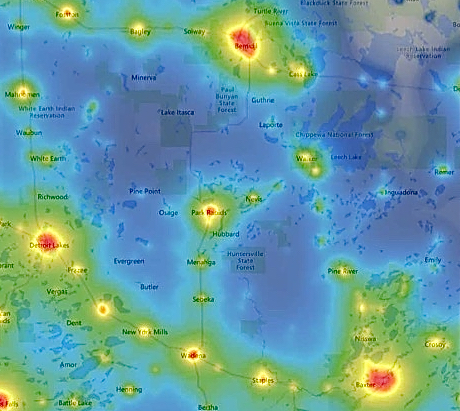When I look at nighttime photos of Long Lake taken from our dock in the 1930s, the shoreline across the lake is blank: no cabins, one resort and lots of undeveloped shoreline. Today, the shoreline has filled in as successive generations of families have settled on the lake, either as full-time residents or vacation home residents. As the shoreline along Long Lake has filled in, so has the nighttime light load with light from lake-shore development and light from the nearby city of Park Rapids.
Like climate warming, micro-plastics and depleted ozone, light pollution is impacting our lake environment in ways that we never imagined. Light pollution, in even small amounts, can profoundly impact our ecosystem.
Over half the insects in the world are nocturnal, including, of course, in Minnesota. Nocturnal insects have evolved over millions of years to be attracted to light, but the natural moon and star light. As the number of lights has increased, the number of insects attracted to those lights has steadily decreased because their life cycles and reproductive patterns have been upended by ever increasing man-made lighting.
Nocturnal animals are affected even more profoundly as increased light disrupts both their sleep cycles and their ability to forage and find prey, an ability adapted over millions of years to night-time life. The best example is the impact of light pollution on the bat population. While many of us are creeped out by bats, we are equally annoyed by mosquitos whose population is bolstered by the presence of artificial light and the heat it produces and is less vulnerable to a falling bat population whose foraging has been negatively impacted by light pollution. Unintended consequences: fewer bats, more mosquitos. (BioScience, Volume 71, Issue 10, October 2021, Pages 1103–
1109)
 |
| Park Rapids lakes area at night using the LightPollutionMap.info link showing the Bortle Class 4 designation |
Even though the lake is 1⁄2 mile wide at our spot, the lights installed across the lake are bright enough for us to read by at night and readily light our bedroom at night.
Like the new “blueish” headlights that are so bright on new cars, the blue/white hue of LED yard lights transmits light waves much farther than traditional incandescent lights and watt for watt shines much more brightly. We all share this lake that we love and in consideration of the insects, plants, fish, and mammals that we share the lake with, we should reconsider how the lighting at our homes and cabins impact the surrounding environment.
- Security lighting should be installed to activate by the motion of a large animal and then shut off quickly if further movement is not detected. Security lighting should be installed so that when illuminated, “light trespass” onto the lake or onto a neighbor’s property doesn’t happen.
- Landscape lighting should be low level, light only walkways and architectural features of a home and not be pointed towards the lake.
- We should all support and advocate for “night sky friendly” lighting in towns and shopping areas to diminish light pollution on the environment.
- International Dark Sky Association: https://www.darksky.org/
- Industry Groups Collaborate to Reduce Global Light Pollution: https://www.architecturalrecord.com/articles/14573- industry-groups-collaborate-to-reduce-global-light-pollution
- Sensible Shoreland Lighting: Wisconsin DNR: https://dnr.wi.gov/topic/ShorelandZoning/documents/shorelandlighting.pdf
Jim Seifert is a third generation Long Lake resident and member of the Board of Directors of the Long Lake Area Association. If you have questions about light pollution or what you can do, please email Jim at jseifertjr@gmail.com
No comments:
Post a Comment